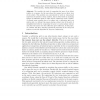Free Online Productivity Tools
i2Speak
i2Symbol
i2OCR
iTex2Img
iWeb2Print
iWeb2Shot
i2Type
iPdf2Split
iPdf2Merge
i2Bopomofo
i2Arabic
i2Style
i2Image
i2PDF
iLatex2Rtf
Sci2ools
ACCV
2006
Springer
2006
Springer
How to Compute the Pose of an Object Without a Direct View?
We consider the task of computing the pose of an object relative to a camera, for the case where the camera has no direct view of the object. This problem was encountered in work on vision-based inspection of specular or shiny surfaces, that is often based on analyzing images of calibration grids or other objects, reflected in such a surface. A natural setup consists thus of a camera and a calibration grid, put side-by-side, i.e. without the camera having a direct view of the grid. A straightforward idea for computing the pose is to place planar mirrors such that the camera sees the calibration grid’s reflection. In this paper, we consider this idea, describe geometrical properties of the setup and propose a practical algorithm for the pose computation.
| Added | 13 Jun 2010 |
| Updated | 13 Jun 2010 |
| Type | Conference |
| Year | 2006 |
| Where | ACCV |
| Authors | Peter F. Sturm, Thomas Bonfort |
Comments (0)

